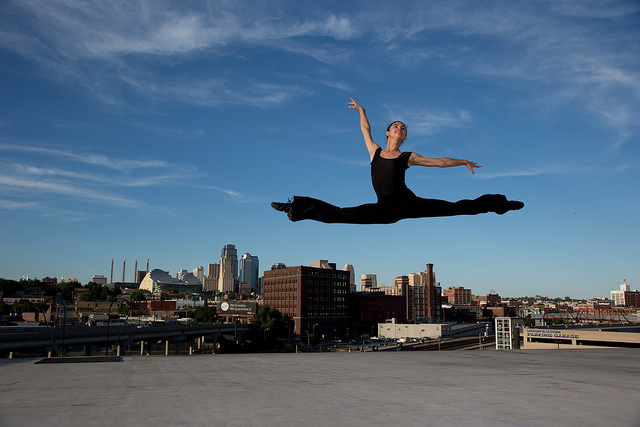You opted to receive this newsletter at DanceAdvantage.net. If you've changed your mind, Opt Out and you won't be contacted again. |
 |
Has Anything Changed? Do You Want It To?
Manage Your Subscription Not a Subscriber? Get more. Get Subscriber PLUS. If you like this article, please share it! Thank you! Individual Goals for Individual Dancers Guest Contributors | Sep 30, 2014 10:34 am  KCB II Dancer Meagan Swisher. Photography by Brett Pruitt & East Market Studios.
Every dancer is different. I know this is a fundamental concept, but it bears repeating. Every dancer brings something beautiful to the stage. Some are beautiful adagio dancers. Others are brilliant jumpers. Then there are those that can tell a story so vividly that Margot Fonteyn herself would be jealous. However, for every strength there is a weakness; something that we find difficult, and sometimes impossible to overcome.
Identify, Assess, AddressAs teachers we have a responsibility to identify and address weaknesses in our students, and help correct them. In some cases, we may need to work with, or around, those weaknesses. Assessing and addressing weakness for individual dancers can be time consuming and frustrating, especially in large classes with a wide variety of body types. However, if you pair your knowledge of the body and dance technique with the dancer’s individual goals, you can address these issues with a bit more ease. Limitations typically fall into one of two categories: they can be either soft tissue or structural. Let’s take a look at each.
Soft Tissue RestraintsSoft tissue restraints involve the balance between muscle strength and flexibility, and are readily addressed. Every dancer wants to be more flexible. Some have short Achilles’ tendons and their pliés are very shallow. Others cannot get their leg higher than 90 degrees in a developé a la seconde. Some have such tight hamstrings that they cannot sit up straight with their legs extended out. At the opposite end of the spectrum are dancers who are hypermobile and struggle to develop the strength to be able to control their flexibility. Whatever the case, strength and flexibility must be balanced for the dancer to be successful at any level. Unfortunately, this balance is not always achieved in dance class. There are several methods for cross-training including Pilates, Yoga and Gyrotonic® that are highly recommended for dancers. All of these methods help strengthen and stretch the entire body. If the limitation is something small, you can give dancers stretches, or strengthening exercises, where appropriate. Instruct them to practice at home, or in their spare time at the studio. Obviously, it is important that they are performing these exercises and stretches correctly, so take a few minutes to make sure they are working with proper form.
Structural ConstraintsStructural constraints – where the bone structure limits the amount of flexibility – need to be dealt with delicately, in a very sensitive manner. Muscles and other soft tissues are pliable and can be stretched and strengthened. Bones, though, are a different story. Bone structure may dictate that a dancer may never get their splits all the way, or that the foot may never pointe well enough for pointe work. Unfortunately, there is nothing you can do to change bone structure. This is where you need to consider the dancer’s goal’s. For example; I have a dancer in ballet class who is an incredibly hard working young woman and has absolutely no more than 90 degrees of turn-out. We have already exhausted our stretching and strengthening options and I am almost positive that the turnout limitation is structural. If she aspired to dance for American Ballet Theatre, we would have to have a career altering discussion. However, she would rather dance for a contemporary or modern company. So, she needs to be able to access her “turnout muscles,” but by no means does she need to rotate her legs to 180 degrees. She works at 90 degrees in ballet class. She has what she has and we work with it. Once you see that there is a possible structural issue, consider the dancers goals and determine how much the limitation is really going to affect her or him. Maybe it is something you can work with or around to help the dancer achieve their goal. If not, and it looks like you might have to have a career altering discussion, send the dancer in to see a physical therapist with a dance background and request that they have imaging done. It’s always good to have a second opinion; then you will know for sure if there is a structural restraint. It may be that the problem is not structural, but muscular. Then the PT will be able to help out with strengthening exercises or stretches as needed. In each of these categories the plan of attack is the same: Identify the problem. Assess how it will affect the dancer’s individual goals, and how to best work with the limitation. Then address the issue with the dancer. How do you help your students with their individual goals?
Leave a comment on this post Have You Missed These? The Five Freshest at DA Got Curves? Leotards and Skirts That Flatter Interview with Kathryn Morgan Kindness in the Classroom: Moving, Discussing, and Being Our Best Recipes for Dancers: Watermelon Waltz Alignment: Love Your Legs |

|
If you like being a DA insider but feel like the blog updates are too much. Here's what you can do:
1. Update your profile and choose "Send me blog updates... NEVER" 2. Then, read the latest posts via RSS feed instead, while still enjoying the PLUS! Learn more about RSS here: How to Create Your Own Dance "Magazine" Unsubscribe <<Email Address>> from this list. Copyright (C) 2009 Dance Advantage All rights reserved. Manage Your Subscription
You are receiving this email because you opted in at http://danceadvantage.net
Dance Advantage 530 Trail Springs Ct Kingwood, TX 77339 USA |
 Laurel Foley has been dancing for over 20 years, she earned her BA in Dance Pedagogy from Butler University. She currently teaches ballet and children’s dance at Style Dance Academy in Franklin, IN and is enrolled in the BASI Pilates teacher training program.
Laurel Foley has been dancing for over 20 years, she earned her BA in Dance Pedagogy from Butler University. She currently teaches ballet and children’s dance at Style Dance Academy in Franklin, IN and is enrolled in the BASI Pilates teacher training program.